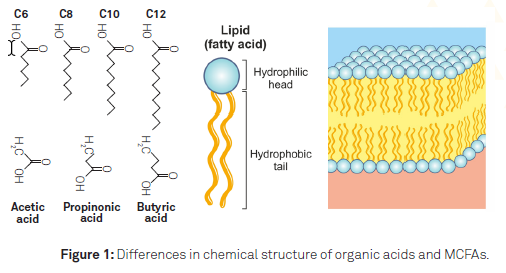Animals have to cope with many challenges along their lifetime often resulting in physiological stress, impaired health and decreased production. These challenges vary in type, severity and duration, and are also influenced by many external factors. Eubisol, based on the original MCFAs, offers a flexible and easy-to-use solution to cope with challenges on farm level.
Medium Chain Fatty Acids (MCFAs)
MCFAs are free fatty acids with a chain length of 6 (C6), 8 (C8), 10 (C10) and 12 (C12) carbon atoms. These natural components have a long standing reputation in the animal feed industry as effective additives for gut health creation. The intestinal ecosystem is a complex environment with many influencing factors, among others, the numerous bacteria interacting with each other, the immune system, gut morphology and other metabolic activities. A balanced microbiota without negative pressure from harmful bacteria is therefore key to achieve a healthy gut.
It is widely accepted and proven that MCFAs have an antibacterial effect by destabilizing bacterial cell membranes. C6 and C8 have greater activity against Gram– bacteria like E. coli or Salmonella, whereas C10 and C12 have greater activities against Gram+ bacteria like Streptococcus or Clostridium. Recent research has also increased insight in the destabilizing effect of MCFAs on enveloped viruses such as PRRSv. Combining the different MCFAs results in a broad spectrum activity against undesired pathogens resulting in a balanced microbiota.
Besides a direct antibacterial effect, MCFAs have also shown to decrease the virulence of pathogens, improve gut morphology and support the immune system. All these actions contribute to healthy animals resulting in improved technical performance.
Mode of action

Steering gut health via drinking water
It is often forgotten that water is one of the most important nutrients to raise healthy animals. On average, animals drink twice as much as what they eat so the importance of water quality should not be underestimated. Parameters defining the drinking water quality are, among others, the pH, the concentration of nitrates and ammonia, the mineral content (Fe, Ca, Cl…) and the bacterial content.
Common practice to improve drinking water quality is the application of organic acids (e.g. formic acid, lactic acid, …). These short chain acids have a strong pH-reducing effect in water. By lowering the pH to a level between 3.6 and 4.0, organic acids work bacteriostatic and in this way contribute to healthier water and a clean water system.
Is this type of organic acids sufficient to steer gut health? To give an answer to this question it’s interesting to look at the chemical characteristics of these molecules, especially when compared to MCFAs.
1) pKa value
Table 1 shows the pKa values of different organic acids and MCFAs. The pKa value is unique for each acid and is equal to the environmental pH at which 50% of the acid appears in its undissociated form and 50% in dissociated form. Acids with a low pKa will mainly appear in their dissociated form lowering the pH of the environment (pH reducing acids). These acids will favor protein digestion in the stomach and will act bacteriostatic in the water lines and stomach. However, the bactericidal effect is limited. In order to work bactericidal, acids need to be neutral to be able to approach the negatively charged bacterial cell membrane. Antibacterial acids have a higher pKa and mainly appear in their undissociated neutral form. Within this list MCFAs have the best characteristics to act bactericidal.
| pH reducing acid (pKa value) | Bactericidal acids (pKa value) |
| Formic acid (3.75) | MCFAs combination (5) |
| Lactic acid (3.83) | Propionic acid (4.88) |
| Butyric acid (4.82) | |
| Acetic acid (4.76) |
2) HLB Balance
A second condition for optimal antibacterial effect of acids is a similar hydrophilic-lipophilic balance (HLB). A bacterial cell membrane consists out of phospholipids. These lipids are amphiphilic, meaning that they contain a hydrophilic and a lipophilic part. To be an efficient destabilizer of the bacterial cell membrane, the HLB of the acid molecule must be similar to that of the bacterial cell membrane. Figure 1 visually shows that the HLB balance of MCFAs is closest to these of bacteria making them more antibacterial than propionic acid, butyric acid and acetic acid, which are too hydrophillic.

In conclusion, based on the pKa value and the HLB balance, MCFAs have the strongest antibacterial properties of all acids. This is also proven in in vitro studies evaluating minimum inhibitory concentration of acids. In order to effectively steer gut health via drinking water, MCFAs are required.
A synergistic mixture for drinking water application
Agrimprove experts recently developed Eubisol, a new solution to tackle challenges on farm level via the drinking water. Eubisol is a synergistic mixture consisting of free and buffered organic acids and MCFAs. Due to new technologies lipophilic MCFAs can now be mixed into the drinking water with guaranteed high and long lasting stability. The combination of MCFAs with organic acids gives maximum synergies on farm and animal level:
1) Healthy water and maintained clean water system
2) Supported and improved digestion
3) Improved gut health by broad spectrum activity against Gram– and Gram+ bacteria
Besides all in vitro and in vivo data on MCFA-based solutions (e.g. Aromabiotic®), Eubisol has already proven its value in many challenging conditions. One example is the reduction of antibiotic use on pig farms with problems around weaning. Supply in small packaging makes Eubisol a flexible and easy solution to apply on the farm during challenging periods.
